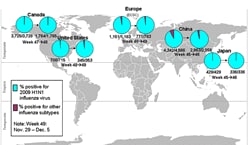You are subscribed to updates from the Centers for Disease Control and Prevention (CDC).
CDC H1N1 Flu Website Situation Update, December 11, 2009
Key Flu Indicators
Each week CDC analyzes information about influenza disease activity in the United States and publishes findings of key flu indicators in a report called FluView. During the week of November 29-December 5, 2009, influenza activity decreased over the previous week across all key indicators except for deaths, but most indicators remain higher than normal for this time of year. Below is a summary of the most recent key indicators:
- Visits to doctors for influenza-like illness (ILI) nationally decreased again this week over last week. This is the sixth consecutive week of national decreases in ILI after four consecutive weeks of sharp increases. While ILI has declined, visits to doctors for influenza-like illness remain elevated nationally.
- Influenza hospitalization rates have decreased across all age groups but remain higher than expected for this time of year. Though declining, hospitalization rates continue to be highest in children 0-4 years old.
- The proportion of deaths attributed to pneumonia and influenza (P&I) based on the 122 Cities Report increased over the previous week and has been higher than expected for ten consecutive weeks. In addition, 16 flu-related pediatric deaths were reported this week: 13 of these deaths were associated with laboratory confirmed 2009 H1N1, 2 were associated with influenza A viruses that were not subtyped and one was associated with a seasonal influenza B virus. Since April 2009, CDC has received reports of 267 laboratory-confirmed pediatric deaths: 224 due to 2009 H1N1, 41 pediatric deaths that were laboratory confirmed as influenza, but the flu virus subtype was not determined, and two pediatric deaths were associated with seasonal influenza viruses. (Laboratory-confirmed deaths are thought to represent an undercount of the actual number. CDC has provided estimates about the number of 2009 H1N1 cases and related hospitalizations and deaths. The increase in the proportion of deaths as other indicators are going down is not surprising as the occurrence and reporting of deaths usually lags behind that of other indicators.
- Fourteen states are reporting widespread influenza activity; a decline of 11 states from last week. They are: Alabama, Alaska, Arizona, California, Connecticut, Delaware, Kentucky, Maine, New Hampshire, New Jersey, New York, Rhode Island, Vermont, and Virginia
- Almost all of the influenza viruses identified so far continue to be 2009 H1N1 influenza A viruses. These viruses remain similar to the virus chosen for the 2009 H1N1 vaccine, and remain susceptible to the antiviral drugs oseltamivir and zanamivir with rare exception.
*All data are preliminary and may change as more reports are received.
U.S. Situation Update
U.S. Patient Visits Reported for Influenza-like Illness (ILI)

U.S. Influenza-like Illness (ILI) Reported by Regions

|
Cases Defined by
|
Hospitalizations
|
Deaths
|
|
|---|---|---|---|
| Influenza Laboratory-Tests** | 33,490 | 1,445 | |
|
*Reports can be based on syndromic, admission or discharge data, or a combination of data elements that could include laboratory-confirmed and influenza-like illness hospitalizations. *Laboratory confirmation includes any positive influenza test (rapid influenza tests, RT-PCR, DFA, IFA, or culture), whether or not typing was done. The table shows aggregate reports of all laboratory confirmed influenza hospitalizations and deaths (including 2009 H1N1 and seasonal flu) since August 30, 2009 received by CDC from U.S. states and territories**. This table will be updated weekly each Friday at 11 a.m. For the 2009-2010 influenza season, states are reporting based on new case definitions for hospitalizations and deaths effective August 30, 2009. CDC will continue to use its traditional surveillance systems to track the progress of the 2009-2010 influenza season. For more information about influenza surveillance, including reporting of influenza-associated hospitalizations and deaths, see Questions and Answers: Monitoring Influenza Activity, Including 2009 H1N1. The number of 2009 H1N1 hospitalizations and deaths reported to CDC from April – August 2009 is available on the Past Situation Updates page. For state level information, refer to state health departments. International Human Cases of 2009 H1N1 Flu Infection
**States report weekly to CDC either 1) laboratory-confirmed influenza hospitalizations and deaths or 2) pneumonia and influenza syndrome-based cases of hospitalization and death resulting from all types or subtypes of influenza. Although only the laboratory confirmed cases are included in this report, CDC continues to analyze data both from laboratory confirmed and syndromic hospitalizations and deaths. |
|||
|
Date Reported
|
Laboratory-Confirmed 2009 H1N1 Influenza Pediatric Deaths
|
Laboratory-Confirmed Influenza A Subtype Unknown Pediatric Deaths
|
Laboratory-Confirmed
Seasonal Influenza |
Total |
|---|---|---|---|---|
| This Week (Week 48, November 29-December 5, 2009) | 13 | 2 | 1 | 16 |
| Since August 30, 2009 | 165 | 38 | 1 | 204 |
| Cumulative since April 26, 2009 | 224 | 41 | 2 | 267 |
|
This table is based on data reported to CDC through the Influenza-Associated Pediatric Mortality Surveillance System. Influenza-associated deaths in children (persons less than 18 years) was added as nationally notifiable condition in 2004. For more information about influenza-associated pediatric mortality, see FluView. |
||||
For more information about the U.S. situation, see the CDC H1N1 Flu U.S. Situation page.
International Situation Update
 This report provides an update to the international situation as of December 11, 2009. The World Health Organization (WHO) continues to report laboratory-confirmed 2009 H1N1 flu cases and deaths on its Web page. These laboratory-confirmed cases represent a substantial underestimation of total cases in the world, as many countries focus surveillance and laboratory testing only on people with severe illness. The 2009 H1N1 influenza virus continues to be the predominant influenza virus in circulation in the world. For the most recent week in which data are available
(November 22 to November 28, 2009) more than 89.4% of influenza specimens reported to WHO were 2009 H1N1. In temperate regions of the Southern Hemisphere, sporadic cases of 2009 H1N1 have been reported in recent weeks but no sustained transmission has been observed. In tropical regions of the Americas and Asia, influenza activity due to 2009 H1N1 remains variable. In temperate regions of the Northern Hemisphere, influenza-like illness (ILI) activity due to 2009 H1N1 has passed its highest peak
in North America and in parts of Western, Northern, and Eastern Europe, but activity continues to increase in parts of Central and Southeastern Europe, as well as in South and East Asia.
This report provides an update to the international situation as of December 11, 2009. The World Health Organization (WHO) continues to report laboratory-confirmed 2009 H1N1 flu cases and deaths on its Web page. These laboratory-confirmed cases represent a substantial underestimation of total cases in the world, as many countries focus surveillance and laboratory testing only on people with severe illness. The 2009 H1N1 influenza virus continues to be the predominant influenza virus in circulation in the world. For the most recent week in which data are available
(November 22 to November 28, 2009) more than 89.4% of influenza specimens reported to WHO were 2009 H1N1. In temperate regions of the Southern Hemisphere, sporadic cases of 2009 H1N1 have been reported in recent weeks but no sustained transmission has been observed. In tropical regions of the Americas and Asia, influenza activity due to 2009 H1N1 remains variable. In temperate regions of the Northern Hemisphere, influenza-like illness (ILI) activity due to 2009 H1N1 has passed its highest peak
in North America and in parts of Western, Northern, and Eastern Europe, but activity continues to increase in parts of Central and Southeastern Europe, as well as in South and East Asia.
For more information about the international situation, see the CDC H1N1 Flu International Situation page.
CDC Experts Contributing to WebMD's Focus on Flu Blog
 In collaboration with WebMD, experts from the Centers for Disease Control
and
Prevention are guest blogging and helping to answer questions on WebMD's Focus on Flu Blog. Check out recent CDC blog posts by Anthony Fiore, MD, MPH, medical epidemiologist with the CDC's Influenza Division -- "How Many People
Have Had H1N1 Flu?" and "Children and H1N1 Flu."
In collaboration with WebMD, experts from the Centers for Disease Control
and
Prevention are guest blogging and helping to answer questions on WebMD's Focus on Flu Blog. Check out recent CDC blog posts by Anthony Fiore, MD, MPH, medical epidemiologist with the CDC's Influenza Division -- "How Many People
Have Had H1N1 Flu?" and "Children and H1N1 Flu."
Recent Updates of Interest
- UPDATE: 2009 H1N1 Flu International Situation Update
This report provides an update to the international situation as of December 11, 2009. The World Health Organization (WHO) continues to report updated 2009 H1N1 flu-associated laboratory-confirmed cases and deaths on its Web page. - UPDATE: Weekly FluView Map and Surveillance Report for Week Ending December 5, 2009
During the week of November 29-December 5, 2009, flu activity declined in the United States as reported in FluView. The number of states reporting widespread flu activity decreased from 25 to 14. - UPDATE: Influenza and Pneumonia-Associated Hospitalizations and Deaths from August 30 to December 5, 2009
As of December 8, 2009, there have been 33,490 laboratory-confirmed influenza-associated hospitalizations and 1,445 deaths in the U.S. from August 30 to December 5, 2009. - NEW: In the News: Deaths related to 2009 H1N1 & American Indians and Alaskan Natives
Questions and Answers on the 2009 H1N1 burden of mortality and American Indians and Alaska Natives. - NEW: 2009 H1N1 and Seasonal Flu and African American Communities: Questions and Answers
These questions and answers summarize the current understanding of the impact of 2009 H1N1 and seasonal influenza virus on African Americans, describe some of the barriers to uptake of 2009 H1N1 and seasonal influenza vaccines, and outline potential strategies for improving health and increasing vaccine coverage in African American communities. - Update: CDC Estimates of 2009 H1N1 Influenza Cases, Hospitalizations and Deaths in the United States, April - November 14, 2009
CDC has updated its estimates of the total number of 2009 H1N1 cases, hospitalizations and deaths in the United States since April, 2009. - NEW: In The News Question & Answer on The Estimated Number of U.S. 2009 H1N1 Cases, Hospitalizations and Deaths
A summary of CDC's updated estimates on 2009 H1N1 cases, hospitalizations and deaths. - PRESS BRIEFING: December 10, 2009
Weekly 2009 H1N1 Flu Media Briefing - Update: 2009 H1N1 Influenza Vaccine
This document provides answers to frequently asked questions about H1N1 vaccine. It also has updated information on vaccine project areas and distribution at the state and local level. - UPDATE: Updated Interim Recommendations for the Use of Antiviral Medications in the Treatment and Prevention of Influenza for the 2009-2010 Season
Information regarding use of intravenous peramivir under an emergency use authorization. Information on availability of renal dosing for peramivir. Updated oseltamivir dosing instructions for children younger than 1 year of age based on weight.
Additional Updates on the CDC H1N1 Flu Website
To learn about other recent updates made to the CDC H1N1 Flu Website, please check the "What's New" page on the CDC H1N1 Flu website.
Get H1N1 Updates & Health Tips via Text Message
 Sign up to get health updates sent via text message. Messages are sent about three times a week with relevant H1N1 flu updates and timely
health tips.
Sign up to get health updates sent via text message. Messages are sent about three times a week with relevant H1N1 flu updates and timely
health tips.
Text UPDATES to 87000 to sign up.
To learn more, see www.cdc.gov/mobile.
Modify/Update Subscriber Preferences | Unsubscribe | Send Feedback | Learn more about CDC Email Updates
To receive the latest news for your region, please update your profile with your country, state and zip code.
Questions or problems? Please contact support@xxxxxxxxxxxxxxx.

|
Fight Flu with Facts! • Visit Flu.gov
|

|
Centers for Disease Control and Prevention (CDC) · 1600 Clifton Rd · Atlanta GA 30333 · 800-CDC-INFO (800-232-4636)

